
Bucharest is the capital and largest city of Romania, as well as its cultural, industrial, and financial centre. It is located in the southeast of the country, on the banks of the Dâmbovița River, less than 60 km (37.3 mi) north of the Danube River and the Bulgarian border.

The Palace of the Parliament, also known as the Republic's House or People's House/People's Palace, is the seat of the Parliament of Romania, located atop Dealul Spirii in Bucharest, the national capital. The Palace reaches a height of 84 metres (276 ft), has a floor area of 365,000 square metres (3,930,000 sq ft) and a volume of 2,550,000 cubic metres (90,000,000 cu ft). The Palace of the Parliament is the heaviest building in the world, weighing about 4,098,500,000 kilograms, also being the second largest administrative building in the world.
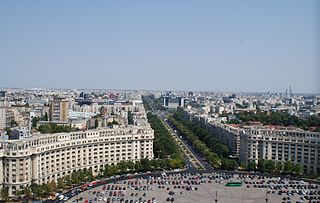
Centrul Civic is a district in central Bucharest, Romania, which was completely rebuilt in the 1980s as part of the scheme of systematization under the dictator Nicolae Ceaușescu, which included the construction of new civic centres in the Romanian cities. Bucharest Civic Centre was planned to become the new political-administrative center of Communist Romania.

University Square is located in downtown Bucharest, near the University of Bucharest. It is served by Universitate metro station.
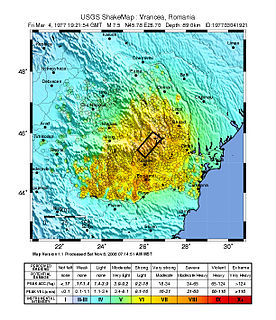
The 1977 Vrancea earthquake occurred on 4 March 1977, at 21:22 local time, and was felt throughout the Balkans. It had a magnitude of 7.5, making it the second most powerful earthquake recorded in Romania in the 20th century, after the 10 November 1940 seismic event. The hypocenter was situated in the Vrancea Mountains, the most seismically active part of Romania, at a depth of 85.3 km.
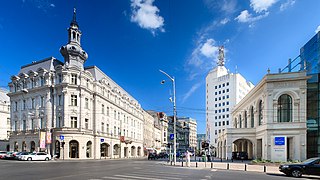
Calea Victoriei is a major avenue in central Bucharest. Situated in Sector 1, and having a length of 2.7 kilometres (1.7 mi), it leads from Splaiul Independenței to the north and then northwest up to Piața Victoriei, where Șoseaua Kiseleff continues north.
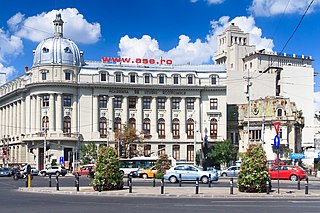
Piața Romană is a major traffic intersection in Sector 1, central Bucharest.
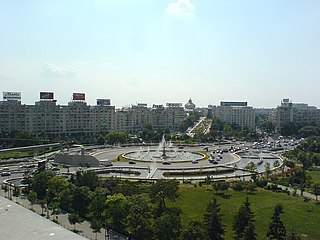
Piața Unirii is one of the largest squares in central Bucharest, Romania, located in the center of the city where Sectors 1, 2, 3, and 4 meet. Part of the Civic Centre, it is bisected by Unirii Boulevard, originally built during the Communist era as the Boulevard of the Victory of Socialism, and renamed after the Romanian Revolution.

Grădina Icoanei is a small park in central Bucharest, situated not far away from Piața Romană and Bulevardul Magheru. The park, located next to Gheorghe Cantacuzino Plaza in Sector 2 of the city, was inaugurated in 1873.

Piața Rosetti is a small square in Sector 2 of Bucharest, 250 metres from Piața Universității. It lies at the intersection of Carol I Boulevard, Hristo Botev Boulevard, Tudor Arghezi Street, Vasile Lascăr Street, Dianei Street, and Radu Cristian Street.

Bucureștii Noi is a district situated in the north-west of Bucharest, Romania, in Sector 1.

The Patria Cinema, located at 12-14 Bulevardul Magheru, was among the best-known movie theatres in Bucharest, Romania. It is housed in Horia Creangă's modernist 10-story ARO building, designed in 1929 and completed in 1931. It was closed in November 2015, due to seismic risk.
Horia Creangă was an architect and key figure of the modernist movement in Romania. Described as "the true founder of the modernist age" in his native county, he is best known as the designer of the first large scale modernist building in Romania, the ARO building on Magheru Boulevard, Bucharest, completed in 1931.

Carlton Bloc was a residential bloc located in Bucharest, Romania, at 9 Nicolae Bălcescu Boulevard, completed in October 1936. Having 14 floors and a height of 47 metres (154 ft), it was the tallest building in the capital until it completely collapsed in 1940 in an earthquake.

Bulevardul Unirii is a major thoroughfare in central Bucharest, Romania. It connects Constitution Square with Alba Iulia Square, and also runs through Union Square. The Constitution Square end features the Palace of the Parliament, which began construction simultaneously with the boulevard as an architectural unit.
Piața Constituției is one of the largest squares in the centre of Bucharest, Romania. The square is standing face-to-face with the Palace of the Parliament and it is bisected by Bulevardul Unirii and by Bulevardul Libertății. The square is one of the best places to organize concerts and parades of Bucharest. Every year, the mayor of Bucharest organizes the New Year's Party in this square. The square is also used to host military parades in honor of the National Day of Romania.
Duiliu Marcu was a Romanian architect, one of the most well known and prolific of the interwar period. With a career spanning from 1912 to 1966, he is said to have designed 150 public and private projects across Romania, his work reflecting the evolution of local architecture in the first half of the 20th century from French Renaissance, though Neo-Romanian to modernism. Though also designing private villas and apartments, he designed some of the major interwar public buildings in the country, including the Timișoara Theatre, the Elisabeth Palace in Bucharest for the royal family, and the Victory Palace, which now houses the office of the Prime Minister.

Calea Moșilor is both a historic street and a major road in Bucharest, Romania. It runs from the back of the Cocor Shopping Mall to Obor.

The Victory Square, known until 1990 as the Opera Square, is the central square of Timișoara. It is the place where Timișoara was proclaimed on 20 December 1989 the first city free of communism in Romania. It was a main boulevard, transformed into a square after the closure of the southern side by the construction of the Metropolitan Cathedral. The opposite poles of the square consist of the Opera to the north and the Metropolitan Cathedral to the south. From the Opera to the Cathedral the promenade on the right is called Corso, and the one on the left is called Surogat. Both have protected architectural ensembles of local historical importance.

Romanian Revival architecture is an architectural style that has appeared in late 19th century in Romanian Art Nouveau, initially being the result of the attempts of finding a specific Romanian architectural style. The attempts are mainly due to the architects Ion Mincu (1852–1912), and Ion N. Socolescu (1856–1924). The peak of the style was the interwar period. The style was a national reaction after the domination of French-inspired Classicist Eclecticism. Apart from foreign influences, the contribution of Romanian architects, who reinvented the tradition, creating, at the same time, an original style, is manifesting more and more strongly. Ion Mincu and his successors, Grigore Cerchez, Cristofi Cerchez, Petre Antonescu, or Nicolae Ghica-Budești declared themselves for a modern architecture, with Romanian specific, based on theses such as those formulated by Alexandru Odobescu around 1870:
"Study the remains – no matter how small – of the artistic production of the past and make them the source of a great art (...) do not miss any opportunity to use the artistic elements presented by the Romanian monuments left over from old times; but transform them, change them, develop them ..."























